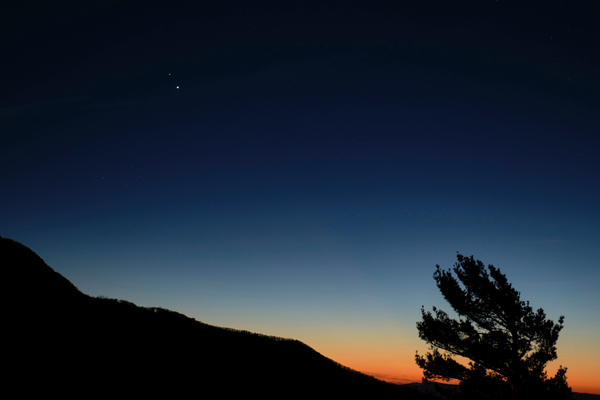
Photo: In this photo last Sunday made available by NASA, Saturn (top) and Jupiter (below) are seen after sunset from Shenandoah National Park in Luray, Virginia. The two planets are drawing closer to each other in the sky as they head towards a “great conjunction” on Monday, where the two giant planets will appear a tenth of a degree apart. (Bill Ingalls/NASA via AP)
Stargazers in North America are getting a glimpse of one of the rarest celestial events, which will peak on Monday’s Winter Solstice, the shortest day of the year.
Saturn and Jupiter are aligning in conjunction in the western sky, in which the planets will appear close together. The brightness of the planets in this conjunction, coupled with its occurrence in December, have many referring to the event as the “Christmas Star.”
The last time the conjunction occurred and the planets appeared this close together was 1623, which was almost impossible see due to the planet’s position to the sun. To have as good a view of the event as is taking place this year, one would have to go back to the year of 1226.
Dr. James Clarke of Mountain Home, a retired physician and amateur astronomer, explains the conjunction.
Listen:
The event is visible to the naked eye, and Clarke offers this advice on how to easily locate the conjunction in the night sky.
Listen:
The conjunction will remain visible until midweek, and Clarke encourages stargazers to view the event several times.
Listen:
Clarke notes the marked differences in the speed of each planet’s orbit around the sun, compared to earth’s.
Listen:
While the term “speed of light” is often bandied about, Clarke says the light that illuminates Jupiter and Saturday is quite old by the time it graces our skies and is indicative of just how far apart our planets are in the solar system.
Listen:
Clarke says a nice pair of binoculars, 20 to 25 power, would allow one to view the rings, or at least their structure, of Saturn. A 25- to 40-power rifle scope would also allow for nice viewing of the event.
WebReadyTM Powered by WireReady® NSI










